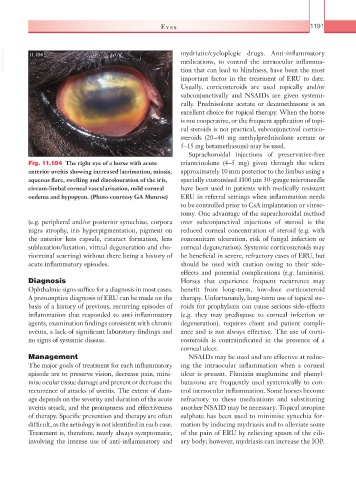Page 1216 - Equine Clinical Medicine, Surgery and Reproduction, 2nd Edition
P. 1216
Eyes 1191
VetBooks.ir 11.104 mydriatic/cycloplegic drugs. Anti-inflammatory
medications, to control the intraocular inflamma-
tion that can lead to blindness, have been the most
important factor in the treatment of ERU to date.
Usually, corticosteroids are used topically and/or
subconjunctivally and NSAIDs are given systemi-
cally. Prednisolone acetate or dexamethasone is an
excellent choice for topical therapy. When the horse
is not cooperative, or the frequent application of topi-
cal steroids is not practical, subconjunctival cortico-
steroids (20–40 mg methylprednisolone acetate or
5–15 mg betamethasone) may be used.
Suprachoroidal injections of preservative-free
Fig. 11.104 The right eye of a horse with acute triamcinolone (4–5 mg) given through the sclera
anterior uveitis showing increased lacrimation, miosis, approximately 10 mm posterior to the limbus using a
aqueous flare, swelling and discolouration of the iris, specially customised 1100 μm 30-gauge microneedle
circum-limbal corneal vascularisation, mild corneal have been used in patients with medically resistant
oedema and hypopyon. (Photo courtesy GA Munroe) ERU in referral settings when inflammation needs
to be controlled prior to CsA implantation or vitrec-
tomy. One advantage of the suprachoroidal method
(e.g. peripheral and/or posterior synechiae, corpora over subconjunctival injections of steroid is the
nigra atrophy, iris hyperpigmentation, pigment on reduced corneal concentration of steroid (e.g. with
the anterior lens capsule, cataract formation, lens concomitant ulceration, risk of fungal infection or
subluxation/luxation, vitreal degeneration and cho- corneal degeneration). Systemic corticosteroids may
rioretinal scarring) without there being a history of be beneficial in severe, refractory cases of ERU, but
acute inflammatory episodes. should be used with caution owing to their side-
effects and potential complications (e.g. laminitis).
Diagnosis Horses that experience frequent recurrence may
Ophthalmic signs suffice for a diagnosis in most cases. benefit from long-term, low-dose corticosteroid
A presumptive diagnosis of ERU can be made on the therapy. Unfortunately, long-term use of topical ste-
basis of a history of previous, recurring episodes of roids for prophylaxis can cause serious side-effects
inflammation that responded to anti- inflammatory (e.g. they may predispose to corneal infection or
agents, examination findings consistent with chronic degeneration), requires client and patient compli-
uveitis, a lack of significant laboratory findings and ance and is not always effective. The use of corti-
no signs of systemic disease. costeroids is contraindicated in the presence of a
corneal ulcer.
Management NSAIDs may be used and are effective at reduc-
The major goals of treatment for each inflammatory ing the intraocular inflammation when a corneal
episode are to preserve vision, decrease pain, mini- ulcer is present. Flunixin meglumine and phenyl-
mise ocular tissue damage and prevent or decrease the butazone are frequently used systemically to con-
recurrence of attacks of uveitis. The extent of dam- trol intraocular inflammation. Some horses become
age depends on the severity and duration of the acute refractory to these medications and substituting
uveitis attack, and the promptness and effectiveness another NSAID may be necessary. Topical atropine
of therapy. Specific prevention and therapy are often sulphate has been used to minimise synechia for-
difficult, as the aetiology is not identified in each case. mation by inducing mydriasis and to alleviate some
Treatment is, therefore, nearly always symptomatic, of the pain of ERU by relieving spasm of the cili-
involving the intense use of anti-inflammatory and ary body; however, mydriasis can increase the IOP.

